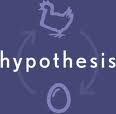EXPERIMENT
Projects of this type involve an original, scientific experiment to test a specific hypothesis. All important variables need to be identified and controlled, except for the one being tested. The results section of the project should demonstrate excellent collection, analysis, and presentation of data. The experimental design is as important as the actual results from the experiment.
The Experimental Process

Formulate the Question. After a few days of reflection, you need to formulate an open-ended question that can only be answered by doing an experiment. Good questions are specific. That is, they are testing the relationship between only 2 variables, not three or four. By keeping the question simple and specific, you are preventing your experiment from taking too long or from being too complicated.

Research your Topic. Once you have identified a question, the next step is to learn as much as possible on the subject. Take some time to do research at the library or on the internet. The object is to be prepared to form an intelligent, testable hypothesis.

Formulate a Hypothesis. This step allows you to focus on the details of the investigation. You need to formulate a hypothesis that can be easily verified with an experiment. A hypothesis has the following: a) subject identified, b) what is being measured, c) variables identified, and d) expected results.
Example: Bean plants grown under a green light 24 hours a day, for a period of 2 weeks, will grow taller than bean plants grown under a natural light over the same period of time.
-
Subject: bean plant
-
Measurement: height of bean plant
-
Independent Variable*: colour of the light / Dependent Variable*: height of plant
-
Result Expected: Green light is better than natural light
* Definitions of the types of variables can be found in the section, Design the Investigation.

Design the Investigation. The plan needs to include the following:
-
Materials needed
-
Variables involved
-
Detailed procedure
-
Data collection plan
Before you begin your experimental design, you need to identify the variables and controls. There are 3 things to identify:
-
Independent Variable: This is the variable that is manipulated. This is what you purposefully change in the experiment.
-
Dependent Variable: The purpose of the experiment is to see if this variable will be affected by the changes you make. The dependent variable is what is being measured in the experiment.
-
Controlled Variables: These are the variables that need to be constant throughout the experiment.

Conduct the Investigation. This is when you actually do the experiment. During the experiment, you may take pictures, record data, and keep detailed notes of observations in your log book.

Analyze the Results. When the experiment is over, you need to compare the results with your hypothesis and form a conclusion. You need to establish if your hypothesis was confirmed or not. At this point, you may have found new questions to be answered and suggest new variables, different materials, or a procedure for another investigation.
Results can occur in 2 forms:
-
If the results can be physically measured, counted and/or if it can be timed, the results are presented in tables and/or graphs.
-
If the results are visuals, illustrations, photographs, or a video recording may be more appropriate.
Conclusions:
-
Discuss or mention every table, graph, illustration, etc. ...
-
Make reference to the hypothesis.
-
Indicate whether or not the results support your hypothesis.
-
Review the variables.
-
Indicate what could be done differently next time to avoid the same mistakes.
-
Highlight some practical applications where this knowledge may be useful.
-
Include ideas for future study.
Video: Preparing for Science Fairs - Conducting Trials
Video: Example Project - Experiment
